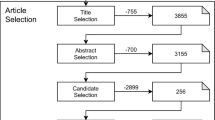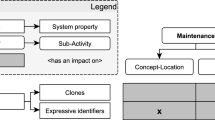Abstract
This work presents MOQARE (misuse-oriented quality requirements engineering), a method to explore quality requirements. The aim of MOQARE is to support intuitive and systematic identification of quality requirements. It was developed by integrating and adapting concepts from other methods (like Misuse Cases). It provides a general conceptual model of quality requirements, and a checklist-based process for deriving them in a top-down fashion. This derivation starts from business goals and vague quality requirements and delivers detailed requirements. MOQARE applies to requirements on the system to be developed requirements, but also derives requirements on the development process, including administration and maintenance. It considers normal and extreme use. The relationships among these requirements are modeled in a Misuse Tree. MOQARE has shown its merits in several case studies, one of which is presented here.


Similar content being viewed by others
Explore related subjects
Discover the latest articles and news from researchers in related subjects, suggested using machine learning.References
Paech B, Kerkow D (2004) Non-functional requirements engineering: quality is essential. In: Regnell B, Kamsties E, Gervasi V (eds) Proceedings of the 10th international workshop on requirements engineering: foundation of software quality—REFSQ 04, Essener Informatik Beiträge Bd 9, Essen, pp 237–250
Sindre G, Opdahl AL (2001) Templates for misuse case description. In: Proceedings of the 7th international workshop on requirements engineering: foundation of software quality—REFSQ 01, Essener Informatik Beiträge Bd.6, Essen, pp 125–136
Sindre G, Firesmith DG, Opdahl AL (2003) A reuse based approach to determining security requirements. In: Proceedings of the 9th international workshop on requirements engineering: foundation of software quality—REFSQ 03, Essener Informatik Beiträge Bd.8, Essen, pp 37–46
Herrmann A, Paech B (2005) Quality misuse. In: Kamsties E, Gervasi V, Sawyer P (eds) Proceedings of the 11th international workshop on requirements engineering: foundation of software quality—REFSQ 05, Essener Informatik Beiträge Bd. 10, Essen, pp 193–199
Kazman R, Klein M, Clements P (2000) ATAM: method for architecture evaluation. CMU/SEI-2000-TR-004, Software Engineering Institution, Carnegie Mellon University
Wiegers KE (2002) Success criteria breed success, The Rational Edge, 2(2)
Firesmith DG (2003) Analyzing and specifying reusable security requirements. Requirements for high assurance systems (RHAS) Workshop
International Standard ISO/IEC 9126. Information technology-Software product evaluation-quality characteristics and guidelines for their use
Chung L, Nixon BA, Yu E, Mylopoulos J (2000) Non-functional requirements in software engineering. Kluwer, Dordrecht
Dörr J, Punter T, Bayer J, Kerkow D, Kolb R, Koenig T, Olsson T, Trendowicz A (2004) Quality models for non-functional requirements. IESE-Report Nr. 010.04/E
Sindre G, Opdahl AL (2000) Eliciting security requirements by misuse cases. Tools Pacific 2000:120–131
Sutcliffe A, Minocha S (1998) Scenario-based analysis of non-functional requirements. In: Dubois E, Opdahl AL, Pohl K (eds) Proceedings of the fourth international workshop on requirements engineering: foundation of software quality—REFSQ 98, Presses universitaires de Namur, Namur, pp 219–234
Firesmith DG (2003) Security use cases. J Object Technol 2(3):53–64
Firesmith DG (2004) Specifying reusable security requirements. J Object Technol 3(1):61–75
Herrmann A, Paech B (2005) Software quality by misuse analysis. Technical report SWEHD-TR-2005-01 (University of Heidelberg). http://www-swe.informatik.uni-heidelberg.de/research/publications/reports.htm
BSI (Bundesamt für Sicherheit in der Informationstechnik = German Ministery for Security in Information Technology) (2004) IT-Grundschutzhandbuch. http://www.bsi.bund.de/gshb/deutsch/g/g01.html
Nakajo T, Kume H (1991) A case history analysis of software error cause-effect relationships. IEEE Trans Softw Eng 17(8):830–838
Lutz RR (1993) Analysing software requirements errors in safety-critical embedded systems. Requirements engineering conference. IEEE Computer Society Press, Silver Spring, pp 126–133
van Lamsweerde A, Brohez S, De Landtsheer R, Janssens D (2003) From system goals to intruder anti-goals: attack generation and resolution for security requirements engineering. RHAS’03 Workshop, pp 49–56
Dörr J, Kerkow D, von Knethen A, Paech B (2003) Eliciting efficiency requirements with use cases. In: Proceedings of the 9th international workshop on requirements engineering: foundation of software quality—REFSQ 03, Essener Informatik Beiträge Bd.8, Essen, pp 37–46
Herrmann A, Rückert J, Paech B (2006) Exploring the interoperability of web services using MOQARE. IS-TSPQ workshop, first international workshop on interoperability solutions to trust, security, policies and QoS for enhanced enterprise systems, 21 March 2006, Bordeaux
Herrmann A (2007) Priorisierung von Qualitätsanforderungen auf der Basis von Risikoabschätzungen. Software & Systems Quality Conferences International 2007, 27 April 2007, Düsseldorf
Herrmann A, Kerkow D, Doerr J (2007) Exploring the characteristics of NFR methods—a dialogue about two approaches. In: Sawyer P, Paech B, Heymans P (eds) Proceedings of the 13th international workshop on requirements engineering: foundation of software quality—REFSQ 07, Springer, pp 320–334
Weiß D, Kaack J, Kirn S, Gilliot M, Lowis L, Müller G, Herrmann A, Binnig C, Illes T, Paech B, Kossmann D (2007) Die SIKOSA-Methodik - Unterstützung der industriellen Softwareproduktion durch methodisch integrierte Softwareentwicklungsprozesse. Wirtschaftsinformatik 49(3):188–198
Alexander I (2002) Initial industrial experience of misuse cases. Requirements engineering conference, pp 61–68
Alexander I (2003) Misuse Cases: Use Cases with hostile intent. IEEE Softw 20(1):58–66
Firesmith DG (2003) Common concepts underlying safety, security, and survivability engineering. Technical note CMU/SEI-2003-TN-033
McDermott J, Fox C (1999) Using abuse case models for security requirements analysis. 15th annual computer security applications conference ACSAC, pp 55–65
Allenby K, Kelly T (2001) Deriving safety requirements using scenarios. requirements engineering conference, pp 228–235
Aagedal JÖ, den Braber F, Dimitrakos T, Gran BA, Raptis D, Stölen K (2002) Model-based risk assessment to improve enterprise security. 5th international EDOC conference, pp 51–62
Moffett JD, Haley CB, Nuseibeh B (2004) Core security requirements artefacts. technical report No 2004/23, Department of Computing, The Open University, UK
Computer security resource center (CSRC). Common Criteria, Version 2.1. http://csrc.nist.gov/cc/
Moore AP, Ellison RJ, Linger RC (2001) Attack modeling for information security and survivability. Technical Note CMU/SEI-2001-TN-001
Lin L, Nuseibeh BA, Ince DC, Jackson M, Moffett JD (2003) Analysing security threats and vulnerabilities using abuse frames. Technical report No: 2003/10, Department of Computing, The Open University, United Kingdom
Liu L, Yu E, Mylopoulos J (2003) Security and privacy requirements analysis with a social setting. Requirements engineering conference, pp 151–161
Object Management Group (2004) UML profile for modeling quality of service and fault tolerance characteristics and mechanisms. http://www.omg.org/docs/ptc/04-09-01.pdf
Blakley B, Heath C, and members of The Open Group Security Forum. Security Design Patterns. http://www.opengroup.org/onlinepubs/9299969899/toc.pdf
Kazman R, Klein M, Barbacci M, Longstaff T, Lipson H, Carriere SJ (1998) The architecture tradeoff analysis method. Software Engineering Institute, Technical report CMU/SEI-98-TR-008
Cysneiros LM, Yu E, Leite JCSP (2003) Cataloguing non-functional requirements as softgoal networks. In: Proceedings of requirements engineering for adaptable architectures, at RE’03, pp 13–20
Mylopoulos J, Chung L, Liao SSY, Wang H, Yu E (2001) Exploring alternatives during requirements analysis. IEEE Softw 18(1):92–96
Liu L, Yu E (2001) From requirements to architectural design—using goals and scenarios. Workshop STRAW, ICSE 2001, http://www.cin.ufpe.br/∼straw01/
Cysneiros LM, Leite JCSP (2001) Driving Non-functional requirements to use cases and scenarios. In: Proceedings of XV Brazilian symposium on software engineering, pp 7–20
Stamatis DH (2003) Failure mode and effect analysis—FMEA from theory to execution. American Society for Quality Press, Milwaukee
BSI (Bundesamt für Sicherheit in der Informationstechnik = German Ministery for Security in Information Technology) (1989) IT security criteria. http://www.bsi.bund.de/zertifiz/itkrit/itgruene.pdf
BSI (Bundesamt für Sicherheit in der Informationstechnik = German Ministery for Security in Information Technology) (1991) Information Technology Security Evaluation Criteria. http://www.bsi.bund.de/zertifiz/itkrit/itsec-en.pdf
Landwehr CE, Bull AR, McDermott JP, Choi WS (1994) A taxonomy of computer program security flaws, with examples. ACM Comput Surv 26(3):211–254
Aslam T (1995) A taxonomy of security faults in the Unix operating system. Master’s thesis, Purdue University
Anton AI, Earp JB, Reese A (2002) Analyzing website privacy requirements using a privacy goal taxonomy. Requirements engineering conference, pp 23–31
Richardson R (2003) 2003 CSI/FBI Computer crime and security survey. Computer Security Institute, http://i.cmpnet.com/gocsi/db_area/pdfs/fbi/FBI2003.pdf
Killourhy KS, Maxion RA, Tan KMC (2004) A Defense-centric taxonomy based on attack manifestations. International conference on dependable systems and networks, pp 102–111
Feigenbaum AV (1961) Total quality control—engineering and management. McGraw-Hill, New York
Herrmann A, Paech B, Plaza D (2006) ICRAD: an integrated process for requirements conflict solution and architectural design. IJSEKE 16(6):1–34
Paech B, Dutoit A, Kerkow D, von Knethen A (2002) Functional requirements, non-functional requirements and architecture specification cannot be separated—a position paper. In: Proceedings of the 8th internationalworkshop on requirements engineering: Foundation of software quality—REFSQ 02, Essener Informatik Beiträge Bd.8, Essen, pp. 102–107
Acknowledgments
MOQARE is the result of the research project SIKOSA, which was funded by the Ministry of Science, Research and Art of Baden-Württemberg, Germany (Ministerium für Wissenschaft, Forschung und Kunst Baden-Württemberg).
We would like to thank Professor Matthias Becker and Damian Plaza of the Interdisciplinary Uveitis Center Heidelberg for their friendly and dedicated cooperation on the case study. We also thank Maike Gilliot and Lutz Lowis from the University of Freiburg and our colleagues from Heidelberg many constructive discussions.
Author information
Authors and Affiliations
Corresponding author
Rights and permissions
About this article
Cite this article
Herrmann, A., Paech, B. MOQARE: misuse-oriented quality requirements engineering. Requirements Eng 13, 73–86 (2008). https://doi.org/10.1007/s00766-007-0058-9
Received:
Accepted:
Published:
Issue Date:
DOI: https://doi.org/10.1007/s00766-007-0058-9




